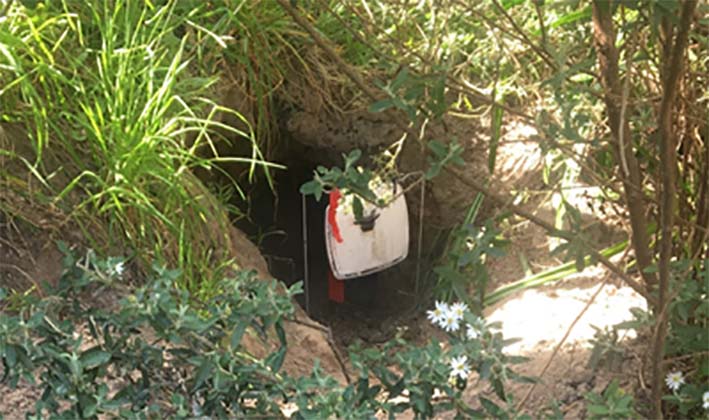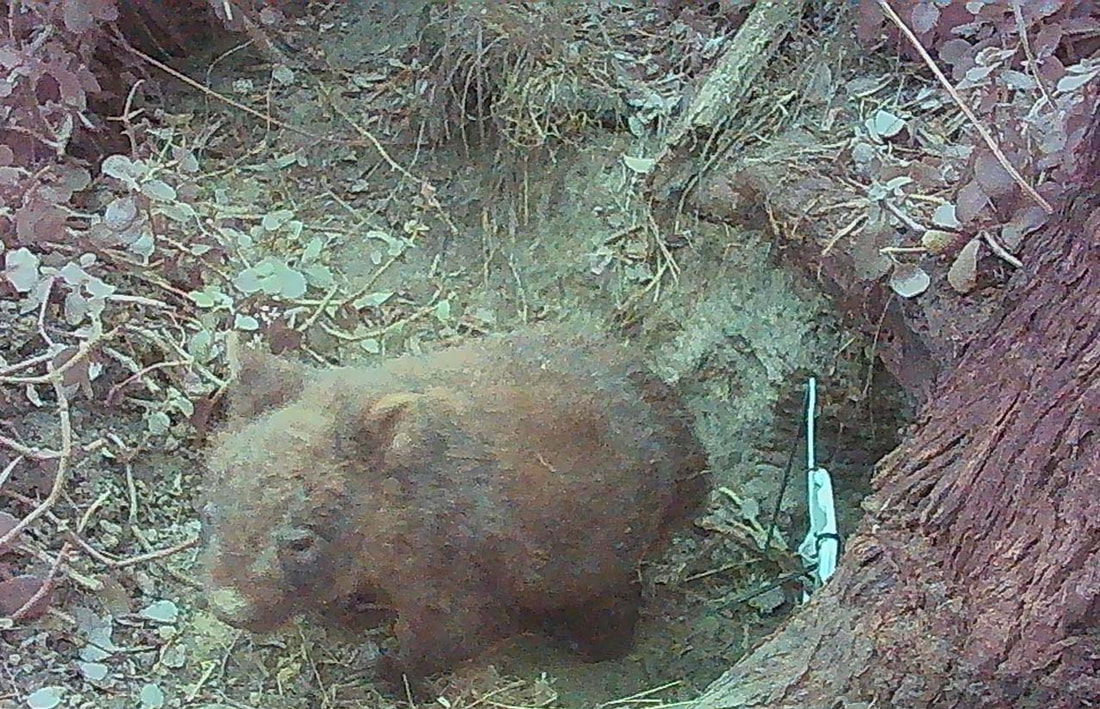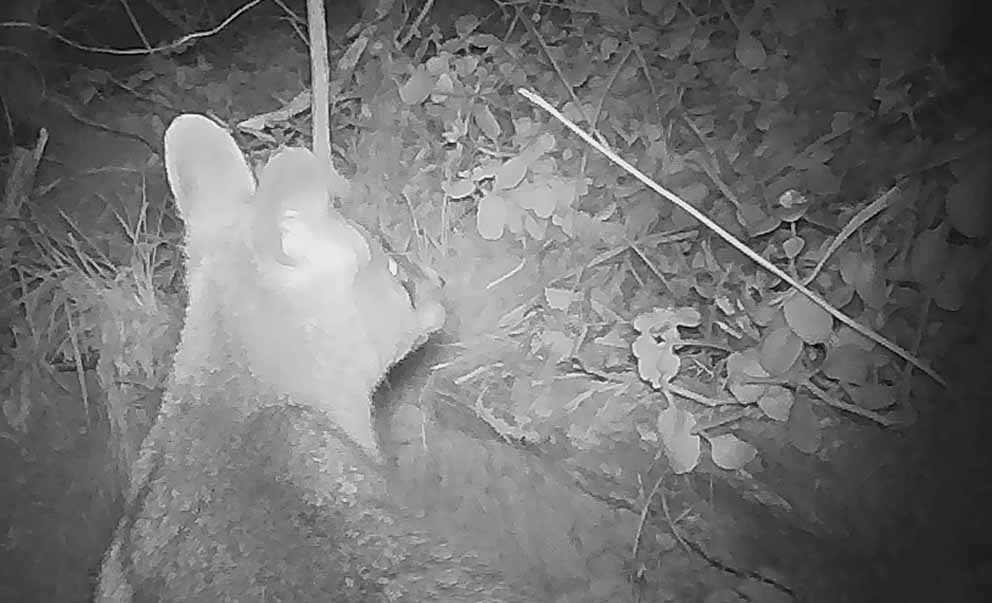Story by Liz McDonald
Photos and captions by Richard Kemp
Photos and captions by Richard Kemp
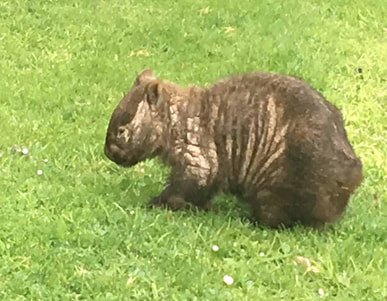 The story starts in July with a very distressed wombat, continuously scratching and covered in a thick scab. That’s when a dedicated team stepped in to help Laribee.
The story starts in July with a very distressed wombat, continuously scratching and covered in a thick scab. That’s when a dedicated team stepped in to help Laribee. I’M VERY happy to encourage native wildlife to my 1.2 ha property in the Gurdies hills. There are at least five wombat burrows on the property used sporadically, and usually scrapings and their prominent poo piles to be seen somewhere each day.
In July I was sorry to see a large wombat grazing voraciously and constantly in full daylight, and scratching his/her side. This was one of the very few sightings in the nearly four decades I’ve lived here. (Alas, we quite often see carcasses on the roadside caused by speeding cars and trucks). I knew that this daylight sighting of a usually nocturnal animal probably meant it was suffering from a dose of mange.
In July I was sorry to see a large wombat grazing voraciously and constantly in full daylight, and scratching his/her side. This was one of the very few sightings in the nearly four decades I’ve lived here. (Alas, we quite often see carcasses on the roadside caused by speeding cars and trucks). I knew that this daylight sighting of a usually nocturnal animal probably meant it was suffering from a dose of mange.
Despite her monthly dose of Nexgard I was also anxious about the possibilities of my new and not yet very sensible or obedient puppy becoming infected. The discomfort the animals are likely to suffer is immense and I’d heard a vet’s treatment is very time-consuming and expensive.
Wildlife Australia referred me to Mange Management, a group of generous and noble volunteers who treat wombats. Ant and Ryan, two local volunteers, visited very speedily and diagnosed mange but treatable as the wombat was quite alert, showed no signs of skin cracking or bleeding, and ran quickly back to his/her burrow. Mange is caused by a tiny mite which lays eggs in the skin and the hatchings become unbearably itchy.
It is customary, I gather, for the volunteers to name their wombats, so this one became Laribee. The wombat treatment kit contains a quantity of Cydectin, the agricultural and veterinary chemical also used for cattle and deer, which is only available under permit. It must be applied to the wombat’s back in measured amounts, ideally every week for 12 weeks.
Wildlife Australia referred me to Mange Management, a group of generous and noble volunteers who treat wombats. Ant and Ryan, two local volunteers, visited very speedily and diagnosed mange but treatable as the wombat was quite alert, showed no signs of skin cracking or bleeding, and ran quickly back to his/her burrow. Mange is caused by a tiny mite which lays eggs in the skin and the hatchings become unbearably itchy.
It is customary, I gather, for the volunteers to name their wombats, so this one became Laribee. The wombat treatment kit contains a quantity of Cydectin, the agricultural and veterinary chemical also used for cattle and deer, which is only available under permit. It must be applied to the wombat’s back in measured amounts, ideally every week for 12 weeks.
The fun started. Ryan kindly visited each week to check the five burrow flaps, and I and neighbour Richard Kemp each managed once to apply a treatment by pole and scoop, easier said than done as Laribee would stay motionless until the last moment before running back to his/her burrow. Did you know that wombats growl loudly and fiercely on approach? I didn’t.
Laribee moved from a spacious burrow in the dam wall to a much smaller one. At least we could see which burrows were being used. And then a much larger wombat appears in Richard's photos and videos. Was he visiting his female friend I wonder?
Richard set up a motion-activated trail camera at the entrance to the burrow which recorded the second wombat. There are some comic photographs of him trying to get through the too narrow wire treatment flap in the entrance. The camera also revealed that the burrow entrance was a nocturnal meeting place for all sorts of other animals, capturing a wallaby, a bush rat and birds.
By mid-September we were no longer seeing either wombat during the day which augers well. Maybe we have managed to get enough treatment on them. May they live long and healthy lives.
*****
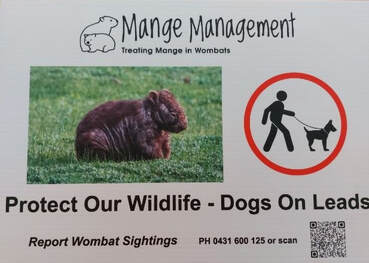
The Post talked to Ant, an experienced local volunteer from Mange Management who oversaw Laribee’s treatment.
Ant: Laribee is one fortunate wombat! Liz, Richard and Ryan all worked wonderfully together and I am so glad that Ryan can see a positive outcome on his first mange patient.
It is rare that we volunteers see this progress. We do our job and cross our fingers and hope for the best. Sometimes we will never know as wombats are solitary nocturnal burrowing animals and are difficult to follow up on. That’s why I love my citizen scientist updates of heathy wombat sightings in the area, hoping it’s one of the special wombats I’ve treated. Stories like Laribee’s give us hope and make us feel we are making a difference.
I want our future generations to enjoy the existence of wombats and not look back on them as an extinct species.
Post: Do you have a local mange management crew?
Ant: We have a great little team of dedicated passionate wombat lovers. Each one of us is allocated our own wombat/s to treat. Ryan, who is treating Laribee, is our newest volly.
Eve and Madeline have been caring for a very sick wombat, Bore Beach Barry, and I take care of a few in the Waterline area. They have finished their course of treatment, but I like to check up on their wellbeing and ensure they do not require further treatment.
We also have our regular citizen scientists: a guy who jogs in Corinella in the evenings gives me updates on fleeting sightings of wombats; private land owners who welcome us onto their property to treat the wombats and ensure their resident wombat continues to live a healthy life; locals who have assisted in educating other locals about wombat mange in our immediate area; and locals who have taken ownership of their visiting wombat and used the mange management treatment kits to care for them.
Post: How difficult is it to treat a sick wombat?
Ant: It’s not an easy job. It is very scary for a sick wombat to be confronted with mange management volunteers trying to treat them for their own good. There are so many variables working against us: the weather, stress, other wombats, dogs, urbanisation. Volunteer Madeline has successfully organised funding for signage to raise awareness and we hope to have many more of these signs made up.
Post: Do you need more volunteers?
Ant: Yes! I am no longer the young fit woman I once was. We are always wanting volunteers to be proactive and take on care of one of their own wombat patients who need treatment. We are always willing to help, give advice, share and support.
Post: What should we do if we notice a sick wombat?
Ant: There is no need to touch or capture the wombat. If you can, take a photo and record the location. Photos are important in assessing a wombat with suspected mange and also for treatment progress. Contact the Mange Management hotline on 0431 600 125 or online at mangemanagement.org.au/report-a-wombat/
Post: How else can we help?
Ant: One of our biggest hindrances to successful treatment is dogs off lead in public areas. So keep your dog on a lead. And if you shop at IGA Ritchies Wonthaggi, take out a Ritchies Community Benefit card and select Mange Management as the organisation you want the Ritchies donation to go to.
For more information or to volunteer, email [email protected]
Ant: Laribee is one fortunate wombat! Liz, Richard and Ryan all worked wonderfully together and I am so glad that Ryan can see a positive outcome on his first mange patient.
It is rare that we volunteers see this progress. We do our job and cross our fingers and hope for the best. Sometimes we will never know as wombats are solitary nocturnal burrowing animals and are difficult to follow up on. That’s why I love my citizen scientist updates of heathy wombat sightings in the area, hoping it’s one of the special wombats I’ve treated. Stories like Laribee’s give us hope and make us feel we are making a difference.
I want our future generations to enjoy the existence of wombats and not look back on them as an extinct species.
Post: Do you have a local mange management crew?
Ant: We have a great little team of dedicated passionate wombat lovers. Each one of us is allocated our own wombat/s to treat. Ryan, who is treating Laribee, is our newest volly.
Eve and Madeline have been caring for a very sick wombat, Bore Beach Barry, and I take care of a few in the Waterline area. They have finished their course of treatment, but I like to check up on their wellbeing and ensure they do not require further treatment.
We also have our regular citizen scientists: a guy who jogs in Corinella in the evenings gives me updates on fleeting sightings of wombats; private land owners who welcome us onto their property to treat the wombats and ensure their resident wombat continues to live a healthy life; locals who have assisted in educating other locals about wombat mange in our immediate area; and locals who have taken ownership of their visiting wombat and used the mange management treatment kits to care for them.
Post: How difficult is it to treat a sick wombat?
Ant: It’s not an easy job. It is very scary for a sick wombat to be confronted with mange management volunteers trying to treat them for their own good. There are so many variables working against us: the weather, stress, other wombats, dogs, urbanisation. Volunteer Madeline has successfully organised funding for signage to raise awareness and we hope to have many more of these signs made up.
Post: Do you need more volunteers?
Ant: Yes! I am no longer the young fit woman I once was. We are always wanting volunteers to be proactive and take on care of one of their own wombat patients who need treatment. We are always willing to help, give advice, share and support.
Post: What should we do if we notice a sick wombat?
Ant: There is no need to touch or capture the wombat. If you can, take a photo and record the location. Photos are important in assessing a wombat with suspected mange and also for treatment progress. Contact the Mange Management hotline on 0431 600 125 or online at mangemanagement.org.au/report-a-wombat/
Post: How else can we help?
Ant: One of our biggest hindrances to successful treatment is dogs off lead in public areas. So keep your dog on a lead. And if you shop at IGA Ritchies Wonthaggi, take out a Ritchies Community Benefit card and select Mange Management as the organisation you want the Ritchies donation to go to.
For more information or to volunteer, email [email protected]
